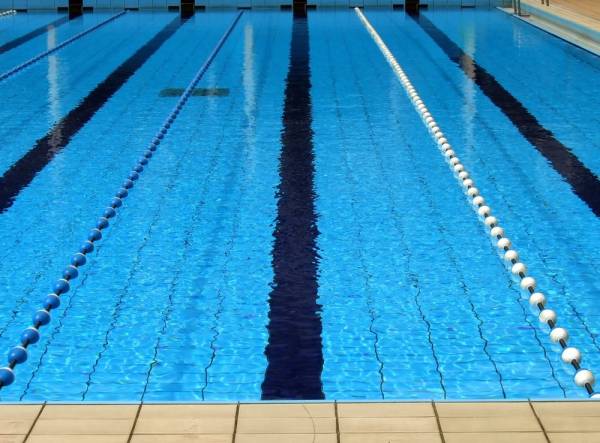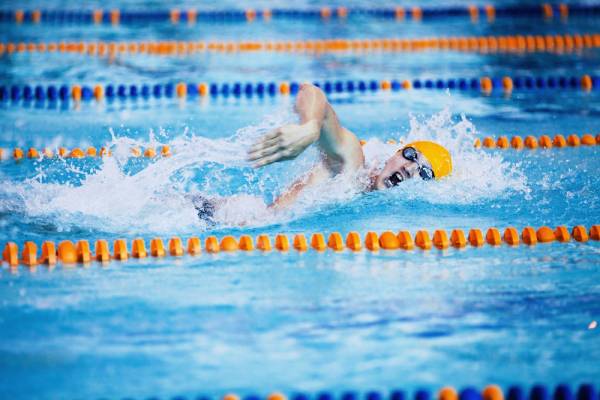I’ve always liked running to stay in good cardiovascular shape. Running is about as efficient as it gets. It doesn’t take much time, burns tons of calories, and to do it you simply open up your front door and go.
Running served me well for years – until my body decided otherwise. About a year ago, both my hip and knee gave me a loud and clear message: enough pavement pounding. Being a stubborn guy, I kept trying to find ways to run, to no avail. Finally, I broke down and got some swim trunks, fins, and goggles. It seems I could run, but not hide from the message my body was giving me.
It was time for a change. Time to swim.
Running vs. Swimming
Unless it’s a sunny day at the beach, I’ve never loved swimming. Swimming as exercise is difficult, awkward, and lacking in distractions. It’s just you and the water. Save snorkeling on a coral reef, there’s nothing to look at – just a black line at the bottom of a pool. There’s no driving music to keep you pumped up and psychologically it seems difficult to maintain intensity in the water.
Still, despite its difficulty, swimming is a great way to stay in shape. It’s a full-body workout, it’s therapeutic, and most importantly, it doesn’t trash your body. I used to love the runner’s high – that moment where all seems right with the world, the endorphins kick in, and I hit my stride.
But the runner’s high comes with a price. When you get home, your body aches and it feels like you just put yourself through the ringer. Yet, I thrived on the intensity of running and had always been able to stay one step ahead of the breakdown running can cause. Until now.
Swimming Is My Less Dysfunctional Girlfriend
My new cardiovascular exercise – swimming – is less sexy, but she’s a better partner. She doesn’t give me those butterflies in the stomach that running does. But, swimming always treats me with respect and makes me feel good.
Swimming is difficult for me because I’m not hard-wired to slow down and face the water. However, there’s also an intriguing thing about swimming. While I’m not as charged in the moment, my body feels better after I do it. It looks like swimming is here to stay.
The Benefits of Swimming: Efficiency
Swimming is both cardiovascular and resistance training. Water is resistance and while you won’t max your bench press from swimming, no doubt you are getting a full-body muscle endurance workout in addition to good cardio.
The Benefits of Swimming: No Distractions
As a coach, I have for years fought the losing battle of trying to get people focused on the present moment and at one with their bodies. It seems people want everything but that quiet moment. Look no further than your local health club and you’ll see exercise options rife with distractions. With swimming, it’s just you and the water.

The Benefits of Swimming: Swimming Is for Everyone
It’s zero impact, so everyone from the supremely fit to the disabled can participate. My mom swims. So does my girlfriend. So do my best friend’s kids. Not everyone is a runner, and as my body told me last fall, neither am I anymore. But everyone can swim. I might not like it the same way I like running, but I do like that come eighty years old, I’ll still be doing it.
The Benefits of Swimming: It’s Good for Your Overall Health
The research on swimming is staggering. People with chronic disease and disability show improved use of affected joints. Other studies show swimming can improve mood in both men and women. Swimmers even have about half the death rate compared to inactive people. Clearly, swimming is great exercise, but it also comes with a whole host of additional health benefits.
The Disadvantages of Swimming: Lack of Efficiency in Time
The swimming checklist goes something like this: Drive to pool. Change. Warm up. Swim. Shower. Change. Drive home. Time = two hours. Compare that with running where your entire checklist is: Lace up shoes, open front door, run, come home and take off shoes. Time = one hour. Clearly, running wins in terms of bang for buck.
The Disadvantages of Swimming: No Distractions
As noted, one of the greatest benefits of swimming is that there are no distractions. Yet, this is exactly why some dislike swimming. It’s nice sometimes to just tune out a bit. On my bike, I enjoy seeing the epic scenery of Boulder, Colorado where I ride frequently. It’s nice on a run to have some hard-charging music to keep you company. It makes the discomfort of exercise somehow more acceptable and even pleasurable. With swimming, it’s more difficult to find that fun because you are forced into that present moment.
The Disadvantages of Swimming: The Smell
I try not to put too many chemicals in my body via what I eat. So, it’s slightly ironic that I bathe in a vat of chlorine three times a week. I’m grateful for chlorine, as it kills things that could otherwise harm me, but trying to get chlorine off your body is no small task. The shower next to the pool doesn’t cut it. You need a scrubber, my friend, and even then, odds are you’re still going to smell like chlorine later in the day.

The Disadvantages of Swimming: Vanity
No disrespect meant to competitive swimmers, as they are in great shape, but if you line up the track and field athletes next to swimmers, generally you can tell who’s who. While swimmers tend to have lean bodies, save maybe at the elite level, they don’t tend to have as ripped of physiques. Don’t get me wrong, the swimmer’s body is ideal in many ways – the V-shape, broad shoulders, and lean muscles – but it’s not like the anaerobic athlete’s body.
According to Louise Burke of the Canadian Institute of Sport, “Elite swimmers may be predisposed to have higher body fat levels because it is a help, or at least less of a disadvantage, to their swimming. Rounded shoulders and smooth curves may be more biomechanically sound than body angles. Higher body fat levels are a greater disadvantage to weight bearing sports like running.” Other studies confirm what the casual observer notes to be true – while swimming is comparable in terms of calorie burn, it doesn’t produce the same results in weight loss to land-based exercise such as running.
My Conclusion on Swimming
I’m still learning the technique of being a proficient swimmer. Truthfully, I don’t look forward to it like I did my running or boxing workouts. Still, I know swimming is good for my body. I know that even if my body heals and I start running (or boxing) again, those days are somewhat numbered.
But my days in the pool can and will stay with me for the whole ride. Swimming isn’t as fun, swimming isn’t as efficient, but swimming has taught me to find that present moment and accept what my body needs. My body feels better as a result of swimming and that’s good enough for me.
References:
1. Louise Burke. “Swimmers Body fat mystery!” Sportsci.org.
2. “Health Benefits of Water-based Exercise,” Centers for Disease Control and Prevention, Page last updated: March 6, 2013
3. NL Chase, et al. “Swimming and all-cause mortality risk compared with running, walking, and sedentary habits in men.” Int J of Aquatic Res and Educ. (2008) 2(3):213-23.
4. BG Berger and DR Owen, “Mood alteration with yoga and swimming: aerobic exercise may not be necessary.” Percept Mot Skills. (1992) 75(3 Pt 2):1331-43.
5. M. Flynn, “Fat storage in athletes: metabolic and hormonal responses to swimming and running.” Int J Sports Med (1990) 11 (6): 433-440.
6. E Gappmeier, “Aerobic exercise in water versus walking on land: effects on indices of fat reduction and weight loss of obese women.” J Sports med Phys Fitness. (2006) 46(4): 564-569.
Photos courtesy of Shutterstock.






